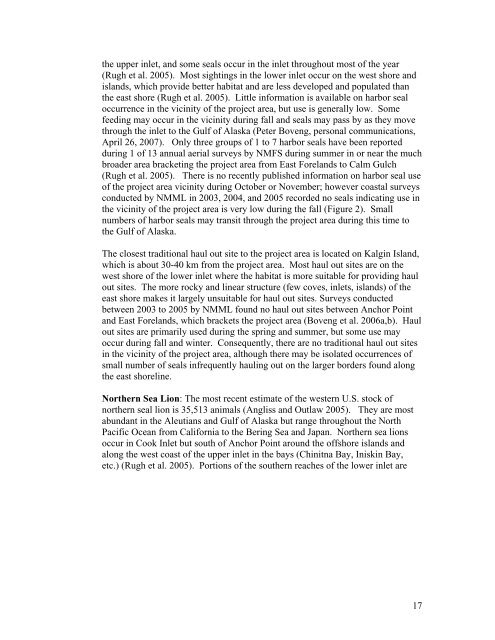IHA Application: Seismic Surveys in Cook Inlet by Marathon Oil ...
IHA Application: Seismic Surveys in Cook Inlet by Marathon Oil ...
IHA Application: Seismic Surveys in Cook Inlet by Marathon Oil ...
Create successful ePaper yourself
Turn your PDF publications into a flip-book with our unique Google optimized e-Paper software.
the upper <strong>in</strong>let, and some seals occur <strong>in</strong> the <strong>in</strong>let throughout most of the year<br />
(Rugh et al. 2005). Most sight<strong>in</strong>gs <strong>in</strong> the lower <strong>in</strong>let occur on the west shore and<br />
islands, which provide better habitat and are less developed and populated than<br />
the east shore (Rugh et al. 2005). Little <strong>in</strong>formation is available on harbor seal<br />
occurrence <strong>in</strong> the vic<strong>in</strong>ity of the project area, but use is generally low. Some<br />
feed<strong>in</strong>g may occur <strong>in</strong> the vic<strong>in</strong>ity dur<strong>in</strong>g fall and seals may pass <strong>by</strong> as they move<br />
through the <strong>in</strong>let to the Gulf of Alaska (Peter Boveng, personal communications,<br />
April 26, 2007). Only three groups of 1 to 7 harbor seals have been reported<br />
dur<strong>in</strong>g 1 of 13 annual aerial surveys <strong>by</strong> NMFS dur<strong>in</strong>g summer <strong>in</strong> or near the much<br />
broader area bracket<strong>in</strong>g the project area from East Forelands to Calm Gulch<br />
(Rugh et al. 2005). There is no recently published <strong>in</strong>formation on harbor seal use<br />
of the project area vic<strong>in</strong>ity dur<strong>in</strong>g October or November; however coastal surveys<br />
conducted <strong>by</strong> NMML <strong>in</strong> 2003, 2004, and 2005 recorded no seals <strong>in</strong>dicat<strong>in</strong>g use <strong>in</strong><br />
the vic<strong>in</strong>ity of the project area is very low dur<strong>in</strong>g the fall (Figure 2). Small<br />
numbers of harbor seals may transit through the project area dur<strong>in</strong>g this time to<br />
the Gulf of Alaska.<br />
The closest traditional haul out site to the project area is located on Kalg<strong>in</strong> Island,<br />
which is about 30-40 km from the project area. Most haul out sites are on the<br />
west shore of the lower <strong>in</strong>let where the habitat is more suitable for provid<strong>in</strong>g haul<br />
out sites. The more rocky and l<strong>in</strong>ear structure (few coves, <strong>in</strong>lets, islands) of the<br />
east shore makes it largely unsuitable for haul out sites. <strong>Surveys</strong> conducted<br />
between 2003 to 2005 <strong>by</strong> NMML found no haul out sites between Anchor Po<strong>in</strong>t<br />
and East Forelands, which brackets the project area (Boveng et al. 2006a,b). Haul<br />
out sites are primarily used dur<strong>in</strong>g the spr<strong>in</strong>g and summer, but some use may<br />
occur dur<strong>in</strong>g fall and w<strong>in</strong>ter. Consequently, there are no traditional haul out sites<br />
<strong>in</strong> the vic<strong>in</strong>ity of the project area, although there may be isolated occurrences of<br />
small number of seals <strong>in</strong>frequently haul<strong>in</strong>g out on the larger borders found along<br />
the east shorel<strong>in</strong>e.<br />
Northern Sea Lion: The most recent estimate of the western U.S. stock of<br />
northern seal lion is 35,513 animals (Angliss and Outlaw 2005). They are most<br />
abundant <strong>in</strong> the Aleutians and Gulf of Alaska but range throughout the North<br />
Pacific Ocean from California to the Ber<strong>in</strong>g Sea and Japan. Northern sea lions<br />
occur <strong>in</strong> <strong>Cook</strong> <strong>Inlet</strong> but south of Anchor Po<strong>in</strong>t around the offshore islands and<br />
along the west coast of the upper <strong>in</strong>let <strong>in</strong> the bays (Ch<strong>in</strong>itna Bay, Inisk<strong>in</strong> Bay,<br />
etc.) (Rugh et al. 2005). Portions of the southern reaches of the lower <strong>in</strong>let are<br />
17
















